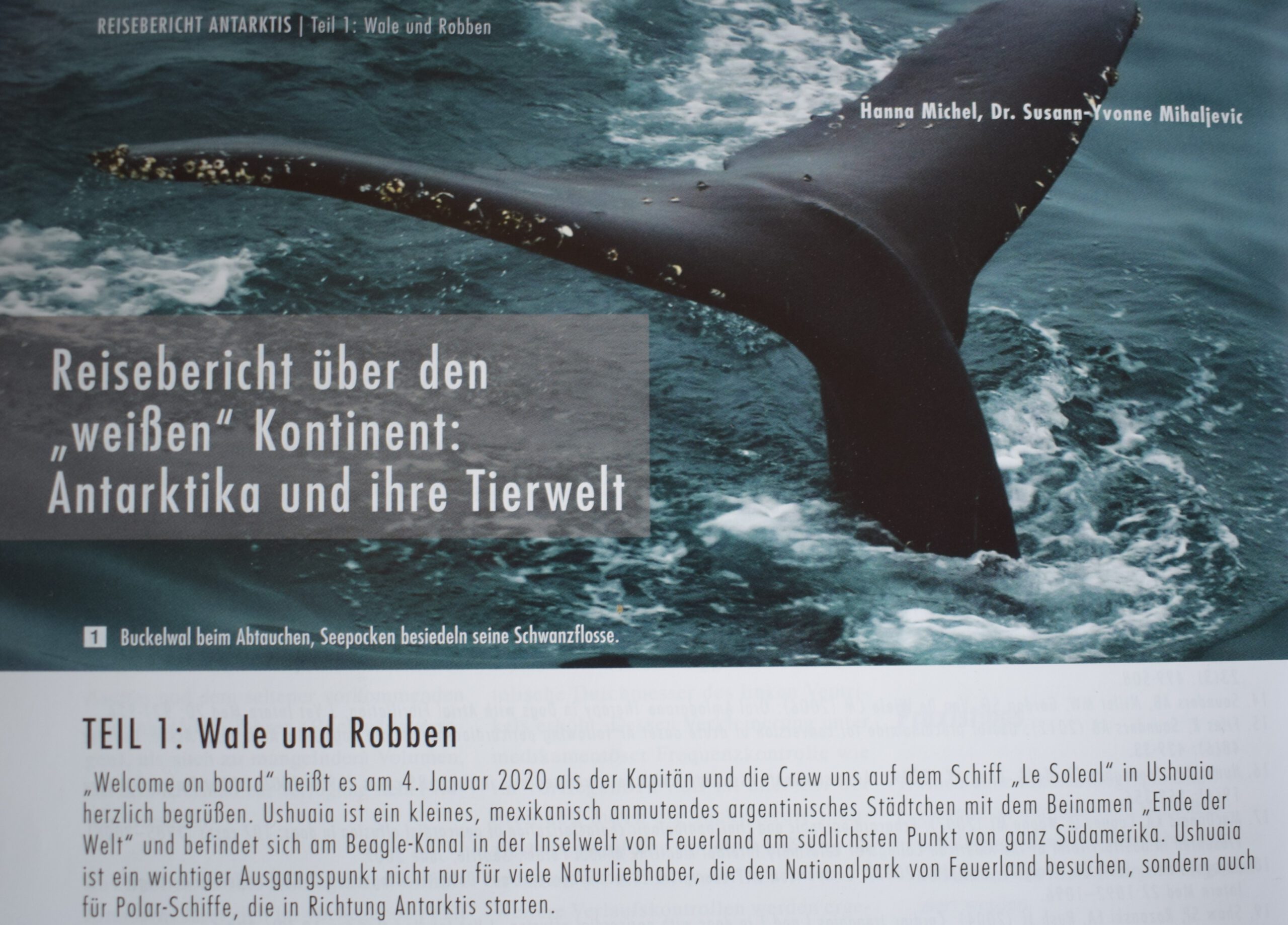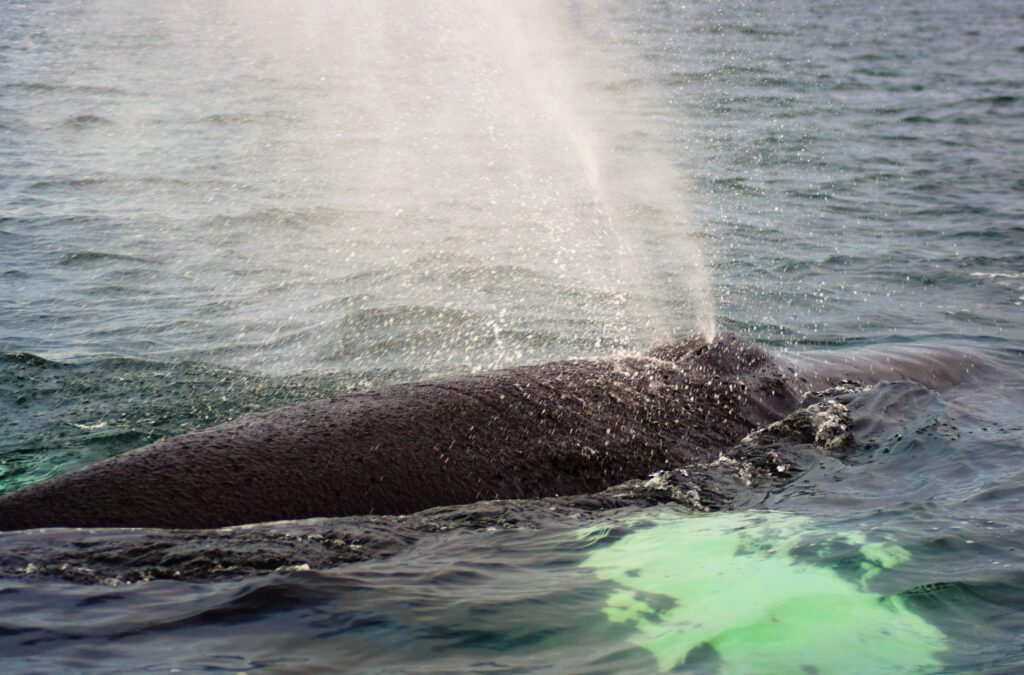Dec 05, 2024
New Article Online: the Talented Singing Seals of Antarctica
🎶Did you know that the icy waters of the Southern Ocean are alive with song? My latest article for WhaleScientists dives into the incredible vocalizations of Antarctic seals—and trust me, their talent rivals even the famous humpback whale songs that captivated the world in the 1970s.
As I prepare for another journey to Antarctica, I’ve been reflecting on the mesmerizing sounds of marine life I’ve been lucky to experience firsthand. From the otherworldly calls of Weddell seals to the haunting melodies of leopard seals, these pinnipeds are true maestros of the ocean. 🦭✨
🌊 Curious to learn more about the fascinating soundscapes of Antarctica? Check out my article on WhaleScientists and uncover the magic of these icy virtuosos.
📖 Seal singers in Antarctica: From love songs to ultrasonic vocalizations
Dec 24, 2023
Movements of Killer Whales in Icelandic
Not an article written by me this time, but the first author of this publication is Tatiana Marchon. Tatiana is a Doctoral Graduate Student at the University of Iceland. She’s doing research on Killer Whales with the Icelandic Orca project located on a small archipelago in the Southwest of Iceland, Vestmannaeyjar (the Westman Islands). Follow them on instagram (@icelandic.orca) to learn more about their awesome work, or check out their website to read more about their current research! I am so happy I was able to make a contribution to this paper when I was working as a biologist and guide on whale watching tours in Iceland a couple of years ago. Great to see this work finally published!
You can find the abstract just below; the entire article which was published on Dec 13 is available here.
Geographical movements, site fidelity and connectivity of killer whales within and outside herring grounds in Icelandic coastal waters
Abstract
Investigating the movements and site fidelity of individuals enhances our understanding of population ecology and structure. Killer whales occur around the coast of Iceland; however, information on the connectivity between different regions is limited to herring grounds, where they are observed frequently. In this study, we used photo-identification data to investigate the movements and site fidelity of whales within (South and West) and outside (Southwest, Northwest, Northeast and East) Icelandic herring grounds. Additionally, we used a 10-year photo-identification dataset in the South to investigate long-term site fidelity patterns to a single location. Of the 440 individuals sighted more than once, nearly half (48%) moved between herring grounds and site fidelity was higher within, compared to outside, herring grounds. Outside herring grounds, individuals showed: more movement from Southwest to West compare to South, indicating this region is not exclusively a passage between herring grounds; low site fidelity to the Northeast with fewer photographic matches to other regions, suggesting individuals found here may be part of an offshore population that occasionally visits the area; and low proportion of matches to other regions in the Northwest and East, although small sample sizes precluded firm conclusions. Finally, long-term residency of killer whales in the South showed dynamic patterns, likely caused by prey availability and/or environmental changes. This study elucidates the complexities of killer whale occurrence and connectivity within the North Atlantic and suggests population structure that should be further investigated for appropriate regional conservation assessments.
November 15, 2022
Dolphins have super healing powers
I am very happy that while I was exploring Antarctica once more my next article for the Whale Scientists was published! This time it’s all about the incredible power of dolphins to recover from severe injuries and trauma. Check it out and be amazed! 😉
Dolphins have super healing powers
March 03,2022
Whale Watching #3: Ups & Downs
The final part: There are so many good things about whale watching. However, it has to be done with care so that both humans and cetaceans can really benefit from it. Find out all about it in PART 3 on the website of the Whale Scientists.
Whale watching can do so much good but can sometimes get out of hands
February 22, 2022
Whale Watching #2: Dos & Don’ts
The timing, the season, the weather – there are so many things to take into consideration when you’re planning your whale watching excursion. Read all about it in PART 2!
Everything you wanted to know about Whale Watching – Part Two
February 16, 2022
Whale Watching #1: Everything you wanted to know!
Before leaving for Antarctica, I wrote an artcile about Whale Watching for the awesome Whale Scientists. The final draft was pretty long, so that it was published in three different parts in the last few weeks. Check out PART 1!
Everything you wanted to know about Whale Watching – Part One
July 19, 2021
Sanctuaries for whales & dolphins
Sanctuaries are a chance for whales & dolphins to retire from captivity. In this article I wrote for the Whale Scientists, you learn more about the world’s first seaside sanctuary for whales in Iceland, and the Whale Sanctuary Project which being planned in Canada. Sanctuaries are an important step towards the end of captivity for cetaceans.
Whale sanctuaries where orcas and belugas can retire from captivity
March 20, 2021
Juicy details about the private life of dolphins
What better to do on a rainy afternoon than reading an article about dolphin vaginas?! 😀 I’m very happy to have my next article for the Whale Scientists published!
Dolphin vaginas will blow your mind
December 12, 2020
Will whales be hunted for profit in the future?
Something to read during all the extra time we have on our hands these days: My second piece for the Whale Scientists, an overview on the commercial whaling situation in Iceland, Norway, and Japan and what the future might look like. ![]()
![]()
Will whales be hunted for profit in the future?
September 26, 2020
Pooping gold: Have you ever heard about ambergris?
I am super happy to have my first contribution as a guest writer for the Whale Scientists published! Keep your eyes open for ambergris during your next walk along the beach! ![]()
![]()
![]()
Pooping Gold? The Valuable Secret of the Sperm Whale
August 15, 2020
„Travel report about the ‚white‘ continent: Antarctica and its wildlife“ – Part 2: Penguins
The second part of our travelogue was published in August 2020.
„Reisebericht über den ‚weißen‘ Kontinent: Antarktika und ihre Tierwelt“ – Teil 2: Pinguine
Der zweite Teil unseres Reiseberichtes erschien im August 2020.

June 15, 2020
„Travel report about the ‚white‘ continent: Antarctica and its wildlife“ – Part 1: Whales & seals
„Reisebericht über den ‚weißen‘ Kontinent: Antarktika und ihre Tierwelt“ – Teil 1: Wale & Robben

On one of my cruises to Antarctica in January 2020, Dr. Susann-Yvonne Mihaljevic and her husband were passengers onboard. Susann is a retired veterinarian and when she returned home, she raved about the experiences of her trip to colleagues. Among them was the editor of a veterinary journal who suggested that she share her impressions in a travelogue. After all, a trip to Antarctica is still quite unconventional. Thereupon Susann contacted me and asked if I was interested in contributing to the report. This ultimately resulted in two reports focusing on the unique fauna of the Antarctic. There was so much to tell that the first part was dedicated to whales and seals, and the second to penguins. Susann reported from her perspective as a passenger about the impressions of her trip, while I contributed scientific paragraphs on the different animal species.
The first part was published in June 2020.

Auf einer meiner Reisen in die Antarktis im Januar 2020 waren Dr. Susann-Yvonne Mihaljevic und ihr Ehemann als Passagiere mit an Bord. Susann ist pensionierte Tierärztin und schwärmte nach der Heimkehr Kollegen von den Erlebnissen ihrer Reise. Darunter war auch der Redakteur einer tiermedizinischen Fachzeitschrift, der ihr nahelegte, ihre Eindrücke doch in einem Reisebericht zu teilen. Eine Reise in die Antarktis ist schließlich immer noch außergewöhnlich. Daraufhin setzte Susann sich mit mir in Verbindung und fragte, ob ich Interesse hätte, bei dem Bericht mitzuwirken. So entstanden letztendlich zwei Berichte, bei denen die einzigartige Tierwelt der Antarktis klar im Mittelpunkt steht. Es gab so viel zu erzählen, dass wir uns im ersten Teil den Walen und Robben widmeten, und im zweiten Teil schließlich die Pinguine zum Zug kamen. Dabei berichtete Susann aus ihrer Perspektive als Passagier von den Eindrücken ihrer Reise, während ich wissenschaftliche Einschübe zu den verschiedenen Tierarten beisteuerte.
Der erste Teil erschien im Juni 2020.

May 01, 2020
„Scaling the Laws of Thermal Imaging–Based whale detection“
Research Article:
Daniel P. Zitterbart, Heather R. Smith, Michael Flau, Sebastian Richter, Elke Burkhardt, Joe Beland, Louise Bennett, Alejandro Cammareri, Andrew Davis, Meike Holst, Caterina Lanfredi, Hanna Michel, Michael Noad, Kylie Owen, Aude Pacini, Olaf Boebel. J. Atmos. Oceanic Technol. (2020) 37 (5): 807–824.
You can find the open access paper here.
Abstract
Marine mammals are under growing pressure as anthropogenic use of the ocean increases. Ship strikes of large whales and loud underwater sound sources including air guns for marine geophysical prospecting and naval midfrequency sonar are criticized for their possible negative effects on marine mammals. Competent authorities regularly require the implementation of mitigation measures, including vessel speed reductions or shutdown of acoustic sources if marine mammals are sighted in sensitive areas or in predefined exclusion zones around a vessel. To ensure successful mitigation, reliable at-sea detection of animals is crucial. To date, ship-based marine mammal observers are the most commonly implemented detection method; however, thermal (IR) imaging–based automatic detection systems have been used in recent years. This study evaluates thermal imaging–based automatic whale detection technology for its use across different oceans. The performance of this technology is characterized with respect to environmental conditions, and an automatic detection algorithm for whale blows is presented. The technology can detect whales in polar, temperate, and subtropical ocean regimes over distances of up to several kilometers and outperforms marine mammal observers in the number of whales detected. These results show that thermal imaging technology can be used to assist in providing protection for marine mammals against ship strike and acoustic impact across the world’s oceans.
Master’s Thesis: „Analysis of the Behavioural Response of Fin and Humpback whales to an Icebreaker using a Thermal Imaging Based whale detection system“
Masterarbeit: „Analyse der Verhaltensreaktion von Finn- und Buckelwalen auf einen Eisbrecher unter Verwendung eines auf Wärmebildern basierenden Erkennungssystems für Wale“
Early 2015 I finished my master’s thesis at the Alfred Wegener Institute for Polar and Marine Research (AWI) in Bremerhaven, Germany. I analysed the behavioural response of fin and humpback whales to the German research icebreaker RV Polarstern under way in the South Atlantic with the help of thermal imaging. It was a great time; I had an excellent supervisor and was offered the chance to be part of a research project in Australia which was related to my thesis‘ topic.
If you’re a true whale nerd with lots of time, you can find more information and a link to a pdf copy here.
Here is a „short“summary of the project and its results:
Cetaceans have evolved a sophisticated auditory sense and rely on sound as principal mean for underwater communication and sensing. Hence, they are affected by noise that is introduced in the world’s oceans by various human activities, and disturbance of marine mammals by anthropogenic noise is of great concern. However, over 30 years after the first studies of the effect of noise on marine mammals, its mechanism is still not understood. Documented effects range from short-term behavioural changes to injury and death, while other studies have shown no effect at all. In this thesis, a ship-based thermal imaging based whale detection system was used for retrospective analysis of the behavioural response of fin and humpback whales to the German research icebreaker Polarstern in the Southern Atlantic Ocean. A total of 17 encounters was analysed; during five of these encounters a behavioural response of the whales was observed. As the vessel approached the whales and came closer, the whales changed their swimming direction from swimming virtually parallel to Polarstern to swimming perpendicularly or in the opposite direction of the ship’s heading. Thereby, the distance between the pods and the ship was increased quickly. The direction change ranged from 43-97°. The five pods showing behavioural responses were observed at minimum distances of up to ~1500 m from Polarstern. Three pods detected in the same range and nine pods observed at greater distances did not show a behavioural change. Therefore, proximity to the ship and, thus, the sound pressure level that the whales received likely played an important role since sound pressure levels decrease with increasing distance to a sound source. The behavioural responses of the five pods suggest that the whales were avoiding high sound levels generated by Polarstern. Furthermore, the behavioural analysis based on thermal imaging turned out better than analysis based on records of visual observers. More whale blows were detected, the distance estimation was more precise, and the behaviour of whales was recognizable in contrast to data recorded by visual observers. To this day, the consequences of short-term behavioural changes due to human disturbance on the population-level are unknown. However, a human-caused increase in low-frequency ambient noise must be considered a potential stressor for all baleen whales, and anthropogenic noise has been hypothesized to be involved in the lack of recovery of several cetacean populations. Additional research is needed to understand its biological significance for marine mammals. Further industrialisation of the oceans would be accompanied by increasing noise levels; however, technological advancements could help to lessen the impact of noise from various anthropogenic activities on marine mammals.

Anfang 2015 habe ich meine Masterarbeit am Alfred-Wegener-Institut für Polar- und Meeresforschung (AWI) in Bremerhaven abgeschlossen. Mit Hilfe von Videos einer Wärmebildkamera analysierte ich die Verhaltensreaktion von Flossen- und Buckelwalen auf den deutschen Forschungseisbrecher RV Polarstern im Südatlantik. Es war eine großartige Zeit, ich hatte einen hervorragenden Betreuer und bekam außerdem die Möglichkeit, an einem Forschungsprojekt in Australien teilzunehmen, das im Zusammenhang mit dem Thema meiner Masterarbeit stand.
Wenn Du ein echter Wal-Nerd mit viel Zeit bist, findest Du weitere Informationen und einen Link zu einer PDF-Kopie hier.
Hier ist eine „kurze“ Zusammenfassung des Projekts und seiner Ergebnisse:
Wale und Delphine haben ein hoch entwickeltes Hörsystem und nutzen hauptsächlich Schall zur Kommunikation und zur Wahrnehmung ihrer Umwelt. Daher sind sie von dem Unterwasserlärm betroffen, der durch zahlreiche menschliche Aktivitäten weltweit entsteht, und die Störung von Meeressäugern durch Lärm bereitet große Sorgen. Allerdings ist mehr als 30 Jahre nach den ersten Studien über den Einfluss von Lärm auf Meeressäuger der genaue Wirkmechanismus weiter unbekannt. Dokumentierte Auswirkungen von Lärm reichen von kurzfristigen Verhaltensänderungen bis hin zu Verletzungen und Tod, während andere Studien keinen Einfluss nachweisen konnten. In dieser Arbeit wurde die Verhaltensreaktion von Finn-und Buckelwalen auf den Deutschen Forschungseisbrecher Polarstern anhand von Aufnahmen einer Wärmebildkamera zur Detektion von Walen im Südatlantik analysiert. Während fünf der insgesamt 17 analysierten Begegnungen wurden Verhaltensreaktionen der Tiere beobachtet. Als sich das Schiff nährte und die Distanz verringerte, änderten die Wale ihre Schwimmrichtung von parallel zu Polarstern um 43-97° und entfernten sich senkrecht von dem Schiff oder schwammen in die entgegengesetzte Richtung. Der Abstand zu Polarstern wurde so schnellstmöglich vergrößert. Die minimale Distanz zwischen Polarstern und den Gruppen von Walen, bei denen eine Verhaltensreaktion zu beobachten war, betrug bis zu ~1500 m. Drei weitere Gruppen innerhalb dieses Bereichs und neun Gruppen, die in größerer Entfernung gesichtet wurden, zeigten keine Verhaltensänderung. Die Nähe zum Schiff und davon abhängend der Schalldruckpegel, dem die Tiere ausgesetzt waren, scheinen daher wichtige Faktoren bei der Reaktion der Wale gespielt zu haben. Die Verhaltensreaktionen der fünf Gruppen legen nahe, dass die Tiere versuchten, die hohen Schallpegel, die von Polarstern verursacht wurden, zu vermeiden. Darüber hinaus stellte sich die Verhaltensanalyse basierend auf Aufnahmen der Wärmebildkamera als besser im Vergleich zu visuellen Beobachtern heraus. Mehr Walblase wurden entdeckt, die Distanzschätzung war genauer, und das Verhalten der Tiere war erkennbar, im Gegensatz zu den Daten von visuellen Beobachtern. Die Konsequenzen kurzfristiger Verhaltensänderungen durch menschliche Störung für eine Population sind bis heute unbekannt. Ein Anstieg von niederfrequentem Unterwasserlärm muss jedoch als potentieller Stressfaktor für alle Bartenwale betrachtet werden und anthropogener Lärm wird für einen von mehreren Faktoren gehalten, der die Erholung gesunkener Wal- und Delphinpopulationen behindert. Weitere Forschungsarbeit ist erforderlich, um dessen biologische Signifikanz für Meeressäuger zu verstehen. Die weitere Industrialisierung der Meere würde mit weiter steigenden Lärmpegeln einhergehen, allerdings können technologische Fortschritte dabei helfen, den Einfluss von Lärm von verschiedenen menschlichen Aktivitäten auf Meeressäuger zu vermindern.



Rheinmetall Defense und das Alfred-Wegener-Institut haben gemeinsam das Wärmebildkamerasystem entwickelt, dass zum Schutz von Walen beitragen soll (AIMMMS – Automatic Infrared Marine Mammal Mitigation System).
Ein möglicher Anwendungsbereich dieses Systems sind Schifffahrten zur seismischen Vermessung, die nach Öl- und Gasvorkommen im Meeresgrund suchen. Dabei kommen extrem laute Schallkanonen zum Einsatz, die negative Auswirkungen auf die akustisch sehr sensiblen Meeressäuger haben können.
Bei meiner Masterarbeit wertete ich Daten dieses Kamerasystems aus und wies nach, dass sich damit Verhaltensreaktionen der Wale auswerten lassen und das System visuellen Beobachtern überlegen ist.
Dieses Video veranschaulicht den Einsatz der Kamera an Bord und erläutert weitere technische Details.

